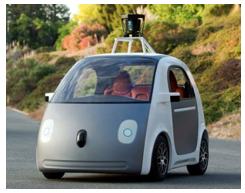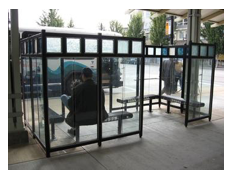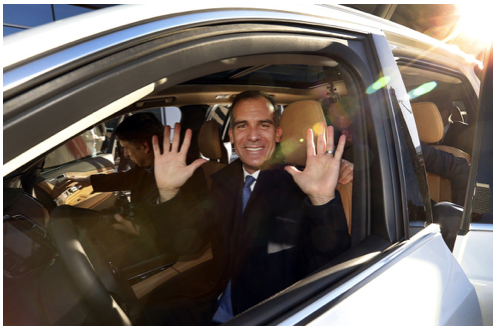CommentsNEW GEOGRAPHY--For a generation, the car has been reviled by city planners, greens and not too few commuters. In the past decade, some boldly predicted the onset of “peak car” and an auto-free future which would be dominated by new developments built around transit.
Yet “peak car,” like the linked concept of “peak oil” has failed to materialize. Once the economy began to recover from the Great Recession, vehicle miles traveled, sales of cars, and particularly trucks, began to rise again, reaching a sales peak the last two year. Instead, it has been transit ridership that has stagnated, and even fallen in some places like Southern California. (Photo above: Los Angeles Mayor Garcetti in driverless car.)
Demographics — notably the rise of the millennial generation — were once seen as the key to unlocking a post-car future. Yes, younger people have been slower to buy cars than their predecessors, much as they have been slow to get full-time jobs, marry or buy homes, but more are now driving, so to speak, the car market, representing the largest share of new automobile buyers.
Convenience can’t be banned
 The persistence of personal transportation has little to do with the much hyped “love affair” with the automobile but convenience and access to work. Simply put, with a few notable exceptions, Americans live in increasingly “dispersed regions.” Transit works brilliantly, as Wendell Cox and I demonstrated recently in a paper for Chapman’s Center for Demographics, to downtown San Francisco and a few other “legacy” urban centers, notably New York which accounts for a remarkable 40 percent of all transit commuting in the United States.
The persistence of personal transportation has little to do with the much hyped “love affair” with the automobile but convenience and access to work. Simply put, with a few notable exceptions, Americans live in increasingly “dispersed regions.” Transit works brilliantly, as Wendell Cox and I demonstrated recently in a paper for Chapman’s Center for Demographics, to downtown San Francisco and a few other “legacy” urban centers, notably New York which accounts for a remarkable 40 percent of all transit commuting in the United States.
Yet, overall, 90 percent of Americans get to work in cars. Access to jobs represents a key factor. University of Minnesota research shows that the average employee in 49 of the nation’s 52 major metropolitan areas can reach barely 1 percent of the jobs in the area by transit within 30 minutes while cars offer upwards of 70 times more access. This practical concern does much to explain why up to 76 percent of all work trips remain people driving alone.
What the future may hold
Cars are rapidly becoming both more flexible and environmentally friendly. Today, autos produce roughly a quarter of all U.S. GHG emissions but emit, according to the EPA, 75 to 90 percent less pollutants than in 1970. Years of emission controls and technological improvements have helped make the automobile, on average, a less conspicuous source of GHG. The EPA projects a 12 percent decline in CO2 emissions from cars while miles traveled increases 11 percent from 2015 to 2025. The U.N. now deems cow emissions more “damaging to the planet” than CO2 from cars.
Perhaps the biggest shift may be to electric cars. China, the world’s biggest car market, plans to allow only electric vehicles in the future. This transition will make cars cleaner, although the high energy cost of producing batteries with their rare metals may create major environment problems. It will also radically boost demand for electricity, mostly powered by coal and other fossil fuels. With nuclear power off the agenda in most western countries, and renewables far short of reliably providing the necessary extra juice, electric cars could produce sweet music to the natural gas industry, which accounts for more than six times as much of electricity generation than wind and solar combined and has been the driving force for U.S. GHG emission declines.
 At the same time, perceptive transit boosters worry that the rise of services like Uber and Lyft could reduce demand for transit, as already has occurred in Los Angeles and even New York. In some places it could totally replace transit with subsidized rides. The final triumph for personalized transportation, owned or not, may come with the rise of autonomous vehicles. Such technologies could both relieve stress for drivers and increase the carrying capacity of the road system through better traffic management.
At the same time, perceptive transit boosters worry that the rise of services like Uber and Lyft could reduce demand for transit, as already has occurred in Los Angeles and even New York. In some places it could totally replace transit with subsidized rides. The final triumph for personalized transportation, owned or not, may come with the rise of autonomous vehicles. Such technologies could both relieve stress for drivers and increase the carrying capacity of the road system through better traffic management.
Not what the planners and connected developers ordered
Whatever the shape and nature of future cars, the automobile era will continue, particularly as millennials flock to the suburbs. Indeed, as auto and telecommunications technology improves, notes a recent Bain report, car-dependency could accelerate. Bain envisions a “post-urban economy” that will be more localized and home-based. By 2025, it reports, fewer people could live in urban cores than in exurbs, which it defines as “beyond the traditional commuting belt.”
The onset of the autonomous car, likely to be halting initially, could accelerate this process, leading to an eventual shift away from car ownership, although this may come a lot slower than some suggest. Automated car proponents claim the cost of operation will be considerably below that of today’s cars and that could further weaken conventional transit outside legacy cores.
Ultimately, rather than the end of cars, we may be entering instead a new phase of the automobile revolution — greener, more efficient and certainly as ubiquitous. How radical these changes, and how rapidly they take place, is debatable. But if we allow market forces to drive change, not authoritarian social engineering, we could achieve better transportation options for future generations than those we have endured in the past.
(Joel Kotkin is the R.C. Hobbs Presidential Fellow in Urban Futures at Chapman University in Orange and executive director of the Houston-based Center for Opportunity Urbanism. This column was posted most recently at New Geography.)
-cw















